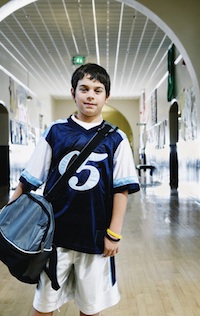Middle School Students Have Surprising Resilience
After nine years of teaching, coaching and counseling young adolescents, Charlie Gramatges has a new job: leading the development of a “true” middle school at K-12 St. Thomas’ Episcopal in Houston, Texas. In his first post, he reflected on the coming school year. Now, as we see, he’s fully immersed.
As I walked through the hallways this week, I could see that the novelty of coming back to school has given way to the recognition that this is only week two of a very long school year.
The students, though very positive and still moving with some spring in their size 5-to-11 steps, are interested in sharing their ups and downs. The lows do not outweigh the highs (and, I hope, never will); however, the students recognize that (1) the lows are a part of life, and (2) like every year, they seem to creep in and challenge every happy-go-lucky bone in their bodies. It’s like having the carpet that you walk on every day swiped from underneath you…yet again.
In the past, noticing this “weight of the world” awareness in the eyes of my students was something I could address easily. I was in the classroom, on the front lines, teaching and motivating (and, yes, I do miss it!). We could talk about battling the schoolhouse drama by balancing subjects, developing better preparation habits and thinking ahead so that a test or paper didn’t sneak up at the last second.
Now I leave that to the teachers. They always do a marvelous job; however, it’s not me doing it…in my own classroom…and that takes some getting used to.
Connecting outside the classroom

Developing the expectation that I am curious about a student’s well-being means asking questions that probe deeper into the life of each student. Now, I’m not saying that I will memorize the personal story of each of the 151 students in the middle school, nor will I necessarily recall a conversation from two weeks ago and follow up without batting an eye. But “personal friendship” isn’t what a student expects, either.
Like most things in a student’s life, they want to know that you are interested in what’s happening right now. Sure, they would be happy to speak about plans for this week or even this year. But in the back of their minds, it’s right now that they need to express. As an administrator, it’s my job to make sure that any child I see in the hallways understands that I care about what is happening to them right now. I’m not “planning for their future” every moment of every day.
Adolescents harbor a natural resilience
Students have resilience built into their programming; it’s in their bloodstream as a mechanism for success. In my opinion, young people are the most willing, the most interested in trying new things. This elasticity provides the rubbery surface on which resilience can stand tall and confident. At times a young person may need a push or a helping hand to find the essence of resilience, but the trait is always ready to do its job. And the need is always there, because the hardest challenge is always the next one.
Middle school students, in particular, realize very quickly that if a challenge doesn’t appear in the classroom, it will rear its head in the hallways, or the locker room, or during lunch. Challenges come in many shapes and sizes, and in most cases, as a surprise serving of difficulty to our young and usually unsuspecting students.
But after every challenge comes a turnaround. Students may feel the lows rise like the tides as the weeks of school press on; they often need someone to turn their heads in order to see what they have already accomplished. Getting to the lowest point, though it seems so dark and gloomy, takes a lot of effort and (in most cases) some form of success along the way. While the past accomplishments do not gain a person any credit for the current challenge, the resilience gained through previous challenges overcome will always remain.
Getting up off the mat

And he lost.
And he lost again.
David hit the mat many times on the way to becoming successful. He was a very confident guy, but the experience of losing time and time again really hit hard. At one point he went to train every day with doubt in his heart. David wasn’t sure if he could get any better; perhaps he had reached a performance ceiling as a result of the limited time he could put into training (he was still a college student, first).
But David had a coach who inspired him. He told him very simply that showing up is the first step to success, so just keep working. When you get knocked down, push yourself up off the mat and keep fighting. Once you realize how to learn from your mistakes, your win column will reap the benefits. So David took the advice of his coach.
He showed up.
He kept trying, he kept getting up.
And…eventually…he starting winning. A LOT.
A boxing match
David’s story inspired me. As I started my work as an administrator for the first time, I realized how fitting David’s story is to the world I live in as an educator. Throughout these past couple of weeks, during New Parent Orientations and Parent Night programs, I have relayed David’s story by sharing my #1 metaphor for middle school:

I use all the values of resilience and grit to describe to families how hard middle school is for students. Getting through one day can be a really big challenge. However, simply showing up every day is half the battle. And when you get knocked down (and you will get knocked down), getting back up and trying again, learning from your mistakes, will win the fight. It’s the road to the championships, and it’s a match we will win together.
Charles E. Gramatges is the Head of Middle School at St. Thomas’ Episcopal in Houston TX. Until very recently, he was a middle school mathematics teacher at St. John’s School, also in Houston, teaching 6th and 7th grade pre-algebra, coaching varsity lacrosse, and serving as an advisor to 6th graders. He writes: “I am very interested in academic innovations via technology and in the great outdoors. From camping to iPads, I thoroughly enjoy discussing ideas regarding ways to stretch the minds of young men and women.” Follow him on Twitter at @cgramatges



































The September editions of ASCD Express and ASCD’s Educational Leadership magazine focus on Resilience and Learning. Two articles, in particular, expand on some of the thoughts shared here by Charlie Gramatges. In “Three Pillars for Supporting Resilience,” Cheryl J. Wright highlights some of the research about factors that influence resilient students’ achievement. And an interview with Angela Lee Duckworth explores her “groundbreaking studies on grit.” We welcome other comments!